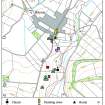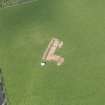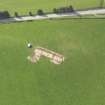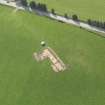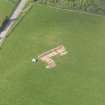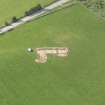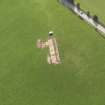Rhynie, Barflat
Enclosure(S) (Period Unassigned), Fort (Period Unassigned)
Site Name Rhynie, Barflat
Classification Enclosure(S) (Period Unassigned), Fort (Period Unassigned)
Canmore ID 281408
Site Number NJ42NE 217
NGR NJ 4974 2634
Datum OSGB36 - NGR
Permalink http://canmore.org.uk/site/281408
- Council Aberdeenshire
- Parish Rhynie
- Former Region Grampian
- Former District Gordon
- Former County Aberdeenshire
Excavation (7 April 2011 - 21 April 2011)
NJ 49749 26345 An evaluative excavation over cropmarks and geophysical results at Rhynie was undertaken 7–21 April 2011. The work revealed a series of concentric enclosures centred on a ring ditch and other possible timber structures, and in association with the Class I symbol stone, the Craw Stane. The enclosure features included an inner ditch, an outer ditch, a circular setting of large postholes and a palisade trench. The site experienced at least one significant destruction phase and several of the features showed evidence of burning in situ. Near the Craw Stane, evidence of a rectangular structure, possibly a building, was found including post and beam settings and potential floor layers. Other features included a range of pits and postholes. Artefacts included sherds from probably two different types of imported Late Roman Amphorae of 6th-century date, a fragment of 6th-century continental glass, metalwork, metalworking debris and amber beads. This phase of evaluative work strongly suggests that the Craw Stane and two other symbol stones nearby were associated with a high status 6th-century settlement, but only detailed post-excavation and further phases of fieldwork will elucidate the full sequence.
Archive: University of Aberdeen
Funder: University of Aberdeen, University of Chester, Carnegie Trust for the Universities of Scotland, Society of Antiquaries of Scotland, Society of Antiquaries of London and Historic Scotland
University of Aberdeen/ University of Chester, 2011
Excavation (16 June 2012 - 30 June 2012)
NJ 4974 2634 An excavation was carried out 16–30 June 2012 at Barflat on the 5th- to 6th -century palisaded enclosure and associated structures identified during the first phase of trial excavation in 2011 (DES 2011, 27) and previous geophysical survey and aerial photography.
The excavation included a large proportion of the interior of the enclosures that surround the Craw Stane (NJ 49749 26345). In the area opened in 2012 linear settings of postholes, plank slots and associated features from at least one large timber building were located. These structural features lay within the two ditched enclosures and the palisade identified in 2011. Further sections were dug across the inner and outer ditches and the palisade to clarify the structural elements of the defended enclosures that surround the Craw Stane. The post and beam settings found near the Craw Stane appear to represent elements of an elaborate entrance structure to the fort. Clear evidence for the use of planks in the palisade construction was detected. The substantial area damaged by cattle in 2005 was also revealed during the excavation, underlining the threats to the site.
Artefacts recovered included early medieval metalworking tongs, sherds of imported Late Roman Amphorae (B-ware) of 6th-century date, bronze and iron pins, metalworking moulds for pins and a brooch, glass-working debris and sherds of 6th-century continental glass. This second phase of evaluative work strongly suggests that the Craw Stane and two other symbol stones (the Rhynie Man and a smaller slab) found downslope from the Craw Stane were associated with a high status, possibly royal site, encompassing settlement and ritual dimensions of the 5–6th century AD. Detailed post-excavation including radiocarbon dating will help to further elucidate the full sequence.
Archive: University of Aberdeen (currently)
Funder: British Academy, University of Aberdeen; University of Chester; Society of Antiquaries of Scotland and Carnegie Trust for the Universities of Scotland.
G Noble, University of Aberdeen, M Gondek, E Campbell, O Sveinbjarnarson 2012
2012
Excavation (15 August 2015 - 3 September 2015)
NJ 49749 26345 An evaluative excavation was undertaken, 15 August – 3 September 2015, on the entranceway of the enclosure complex identified at Barflat, Rhynie in 2011– 2012. The excavation targeted the findspot of the Rhynie Man, the entranceway to the complex on the E side and a possible annexe enclosure. Parts of the inner and outer ditch were also revealed and further slots were excavated across the ditch system to retrieve additional material for dating.
During the excavation of sections across the inner and outer ditch numerous artefacts and burnt and unburnt animal bone were retrieved from the outer ditch fills. The inner ditch was much more sterile with only a fragment of a crucible recovered.
The entranceway through the inner and outer ditch and the outer wooden enclosure was found in the eastern part of the trench. The entranceway through the outer enclosure was c3m wide with small postholes set within the outer plank/post wall marking the entry and perhaps supporting a
gateway. Much larger posts were set 2m further in from the outer wall and perhaps supported a box rampart with upper wall-walk. Numerous sherds of Late Roman amphora and a nail-headed bronze pin were found within destruction layers covering the remains of the outer enclosure wall.
Near the Craw Stane, a stone socket, measuring 1.3 x 0.9m, was identified with stone packing on the N side of the feature and animal bone within the basal fill on the S side. Midden/ destruction deposits were found infilling the upper fill of the socket.
A possible annexe enclosure was identified to the N. It consisted of a very truncated ditch or foundation for a turf wall and was found to pre-date the outer enclosure.
Outside the annexe to the E was a small sub-circular pit or remains of a sunken building. This measured 2.5–3m in diameter and was filled with different sands, charred wood and burnt turf/ash deposits. Fragments of Late Roman amphora and two iron buckles were also found in the fills of the feature.
Archive: University of Aberdeen
Funder: University of Aberdeen Development Trust in association with the Tarbat Discovery Centre
Gordon Noble and Meggen Gondek – University of Aberdeen and University of Chester
(Source: DES)
Excavation (5 August 2016 - 1 September 2016)
NJ 49749 26345 An evaluative excavation was undertaken, 5 August – 1 September 2016, at Barflat, Rhynie. This was targeted over the 5th/6th-century palisaded enclosure and associated structures identified during previous geophysical survey and aerial photography and the seasons of excavation in 2011, 2012 and 2015.
The excavation targeted the western and southern parts of the enclosure complex and reopened an area over a possible structure adjacent to the Craw Stane. The enclosures surround the Craw Stane, a Pictish Class I symbol stone that stands in the fields to the S of Rhynie village (NJ 49749
26345). Elements of the inner and outer ditch system, the palisaded enclosure/outer box rampart, and a series of timber settings next to the Craw Stane, were excavated and further characterised in the 2016 excavations. Further sections were dug across the inner and outer ditches and the outer palisaded enclosure clarifying the structural elements of the
enclosure complex that surround the Craw Stane. Artefacts recovered include further sherds from imported Late Roman amphorae, crucible sherds, mould fragments, evidence for metal working and iron smelting. Detailed post-excavation analysis, including radiocarbon dating will help further elucidate the significant archaeological remains identified at the site.
Archive: University of Aberdeen
Funder: University of Aberdeen
Gordon Noble, Meggen Gondek, Cathy MacIver, Daniel MacLean and Ewan Campbell – University of Aberdeen
(Source: DES)
Note (May 2017)
Discovering a Lost People
Modern day Rhynie is a rural village in central Aberdeenshire, surrounded by open countryside. It is a picturesque location, and deceptively modest, for archaeological evidence attests to many centuries of high status settlement in the area. Even the name Rhynie itself is regal, deriving from 'Rig' meaning King. Many Pictish stones have been found here, including the famous 'Rhynie Man', a 6ft high figure carrying an axe, found in a field in 1978.
So who were the Picts, and what were they doing at Rhynie? These are the very questions which are currently being investigated by The University of Aberdeen's Northern Picts project. The project aims to find the Picts in the landscape of Northern Scotland, and has had many notable successes in recent years. The Rhynie Environs Archaeology Project (REAP) is a key case study within the Northern Picts project. It is a collaborative endeavor between the Universities of Aberdeen, Chester and Glasgow and the local community artist collective Rhynie Woman.
Excavations in 2011 and 2012 revealed a series of fortified enclosures near to the the Craw Stane, a Class I Pictish symbol stone which still stands today. This is located at Barflat, northwest of the present day village and very close to where Rhynie Man was found in the 1970s. Early indications were that this was an important settlement. Further work revealed a series of concentric enclosures centred on a ring ditch and other possible timber structures, and in association with the Class I symbol stone. An interpretative reconstruction of the site has recently been completed and it is available to view online. You can access it by clicking on the link below.
Settlement evidence for this period is very rare, and the evidence for Pictish buildings which has been found at Rhynie is extremely important. Equally significant is the evidence for large-scale high status metalworking at the site, and a range of Continental imports which have been found here, indicating without doubt that Rhynie was an important power centre dating from the 4th to the 6th centuries AD. A contemporary cemetery has been found closer to the village.
Contextualising Rhynie / Moulds and Metal
The Rhynie Environs Archaeology Project is investigating the interaction between the high status site here and the wider landscape. The complex at Barflat is close to two small fortified sites at Cairnmore and Wheedlemont, and the great hillfort at Tap O'Noth [see previous Archaeology InSites feature under Age of Iron]. A 5th/6th century phase has been identified at Cairnmore and it is very likely that both Wheedlemont and Tap were in use at this time, but connections between these sites and Rhynie are still to be established. Understanding the links between these sites, and indeed if they are there at all, is key to understanding the development and control of the landscape of the Strathbogie area.
Rhynie has yielded a rich assemblage of high status material. One of the most iconic finds from the site is the axe shaped pin which was found in 2012. This pin, with its serpent design, resembles the axe which is carried by Rhynie Man, now in the reception area of Woodhill House, the headquarters of Aberdeenshire Council. The 2016 excavations revealed the best evidence yet for high status metalworking at Rhynie. Over 50 sherds of crucibles were found at the site, and clay moulds were uncovered in greater numbers than at any other known Pictish site. These moulds produced a range of different pins and brooches. There was even evidence for enameling. The finds from the 2016 season are currently undergoing conservation work, and although less visually striking than the finished products, they have the potential to tell us far more.
Dr Kirsty Owen - Archaeology and World Heritage Team




























